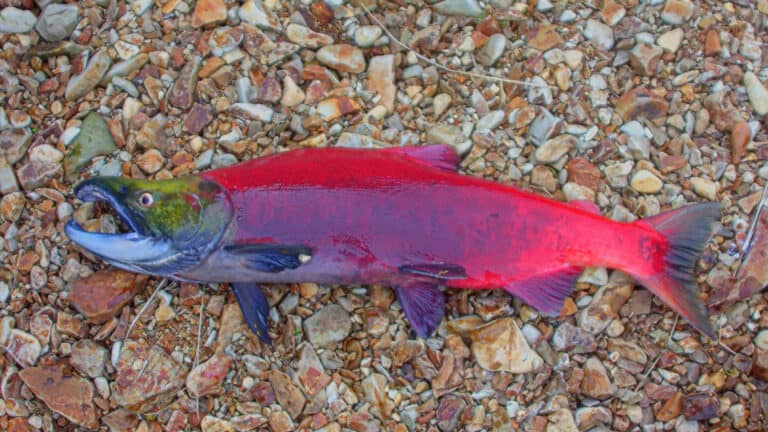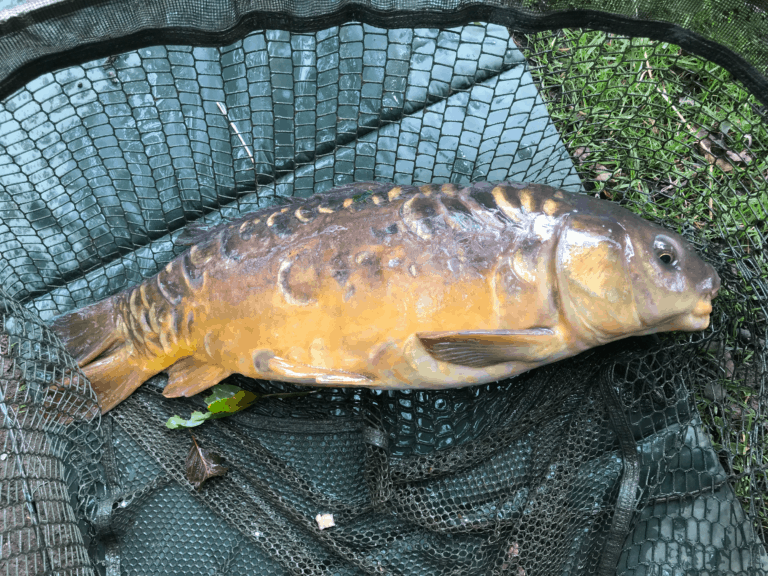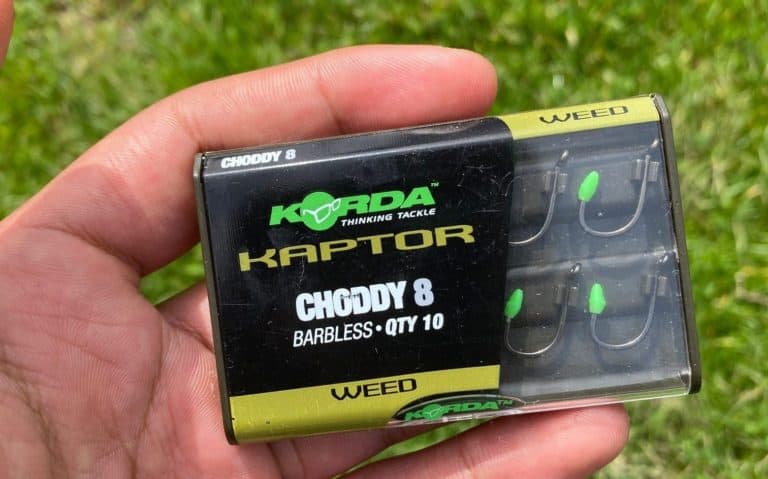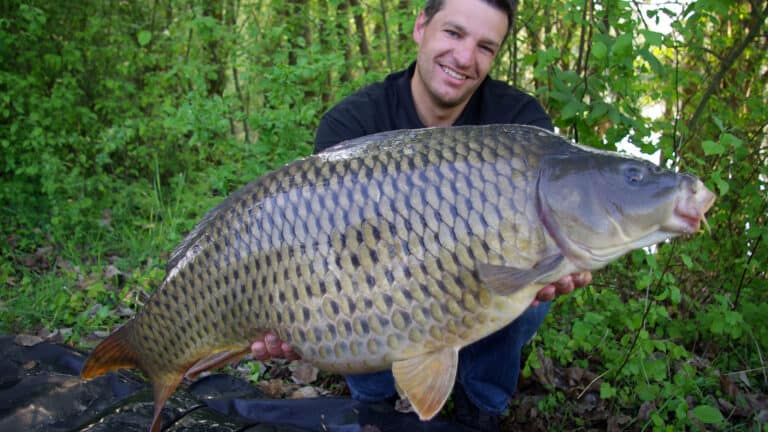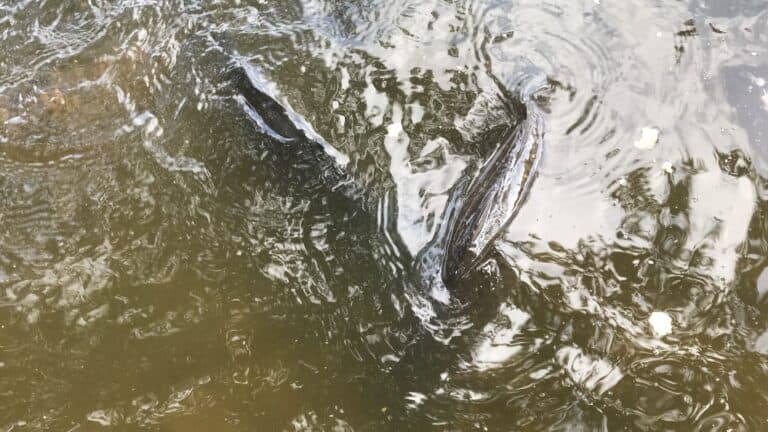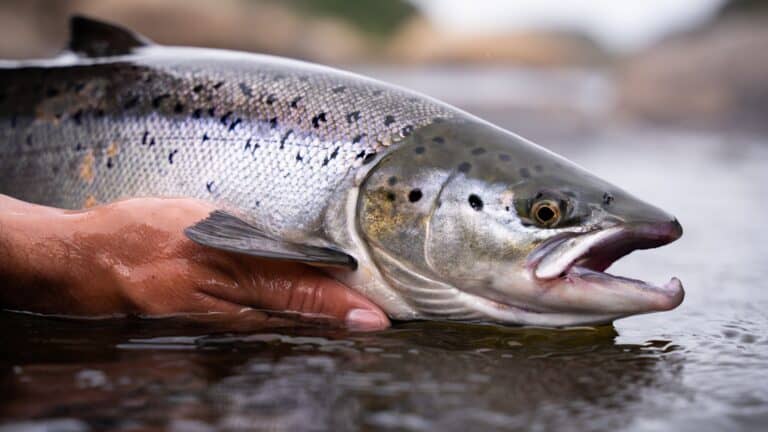How To Catch Atlantic Salmon – A Fisherman’s Guide
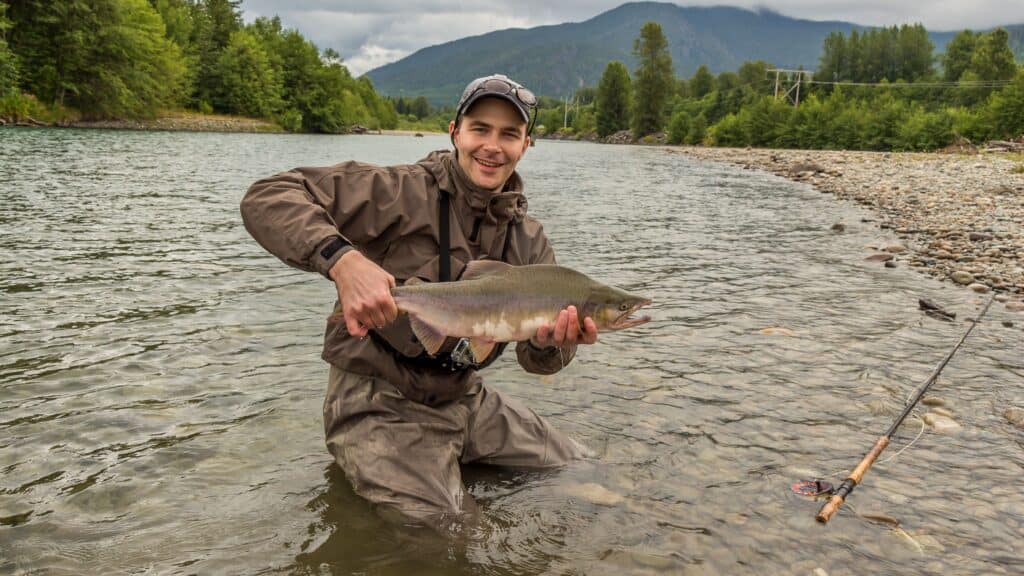
Salmon fishing, for many anglers all over the world Salmon fishing, is a passion that isn’t taken lightly. When answering this question let’s start off by understanding the fundamentals when fishing for Salmon.
Well-known all around the world for its exquisite meat and flavour, this sort after fish can be simple yet somewhat challenging to catch. The Go-to method most anglers use is A double-handed fly rod combined with a fly/lure of your choice. There are different ways to fly fish, using the correct method will all depend on your experience, the time of year, and location.
Unlike many other fish, anglers catch, Salmon are predatory. This means when catching them you have to take a different sort of approach to really ‘Catch’ their attention. In this article, we’ll be covering the basics of how to go about your first salmon fishing trip.
Table Of Contents:
- Getting A Fishing License
- Where To Go Salmon Fishing
- What Tackle You Need For Salmon Fishing
- Setting Up Your Rod & Reel
- Salmon Fishing Rigs
- Best Salmon Fishing Baits
- How To Locate Salmon
- How To Improve Bite Frequency
- When Is The Best Time To Go Salmon Fishing
- How To Handle Salmon
Getting A Fishing License
Before you set out, ensuring you are legally allowed to fish is mandatory. For the UK you must have a fishing license when catching salmon from the age of 13 onwards. The license for children aged 13-16 is free however still must be registered.
When purchasing a fishing license you will need a debit or credit card and your national insurance or blue badge number. Then it’s just a matter of following the simple instructions on the Gov website.
Here’s a breakdown of the cost of your fishing license depending on a few different factors.
| License Type (Time) | Salmon and Sea Trout |
|---|---|
| 1 Day | £12 |
| 8 Day | £27 |
| 12 Months | £82 |
| 12 Months 65+/ Disabled | £54 |
| 12 Months Junior (13-16) | Free |
Where To Go Salmon Fishing
The UK is a great country for Salmon fishing, it’s packed full of heavily stocked rivers. Salmon tend to look for fast flowering clean water when migrating up and down rivers before reaching the cost. One important trait to look out for when finding salmon in a river is the clarity of the water combined with the river’s flow. Salmon tend to prefer highly originated water, this is instilled deep within their biology so a quiet and murky river is best to avoid.
Here’s a list of some of the most popular places to go Salmon fishing throughout the UK.
| Where To Catch Salmon | Fish size |
|---|---|
| The River Wye (Wales & England) | 5-20lbs |
| The River Spey (Scotland) | 5lbs+ |
| The River Dee (Wales & England) | 10lb-30lbs |
| The River Tay (Scotland) | 5lb-45lbs |
| The River Tweed (Scotland) | 13lb-42lbs |
| The River Avon (South West England) | 5lb-30lbs |
| The River Esk (North Yorkshire, England) | 5lb-20lbs |
The rivers listed above are all in the UK. When we break down which countries have the most salmon, Chili and Norway actually produce more than 50% of the world’s Salmon. If money isn’t an object then you may want to consider visiting either one of those countries to get the most out of your salmon fishing. However, bearing in mind that rules and regulations often change and adapt, the UK is a safe bet for Salmon fishing.
What Tackle You (Need) For Salmon Fishing
Salmon tackle can range in price from the surprisingly affordable basic stuff all the way to the more expensive professional gear. For the majority of us, something versatile and robust will do the job perfectly without breaking the bank. Here’s a table that breaks down the essentials:
| Tackle | Price |
|---|---|
| Rod (Shakespeare Ugly Stik Lite Spinning Rod) | (£30-£80) ($36-$96) |
| Reel (Mitchell MX4 Spinning Reel) | (£59) ($71) |
| Flys/Lures (NC 10Pcs Spinner Bait) | (£10) ($12) |
| Baits (PowerBait FW Floating Mice Tails) | (£10) ($12) |
| Line (Seaknight BLADE Nylon Fishing Line 500M/1000M Japanese Material Monofilament) | (£12) ($14) |
Having the right gear for the job may save you a lot of time and money in the long run. Salmon are predominantly caught using light fly rods with shiny lures or flys. Salmon can also have fast predatory instincts depending on where they are in their life cycle. Meaning that small bugs skipping across the surface of the water is an ideal scenario for enticing the salmon in.
Setting Up Your Rod & Reel
When it comes to salmon fishing there are 2 different types of Reels that anglers typically use. A fly reel which is a lot simpler looking and lightweight and a standard reel that can be used to fish for multiple species of fish. To keep things simple something using a generic fishing reel is probably your best bet.
An easy but essential part of fishing, setting up your rod and reel should be done before or when at the river bank. Here’s a quick step-by-step guide on how to get this done efficiently:
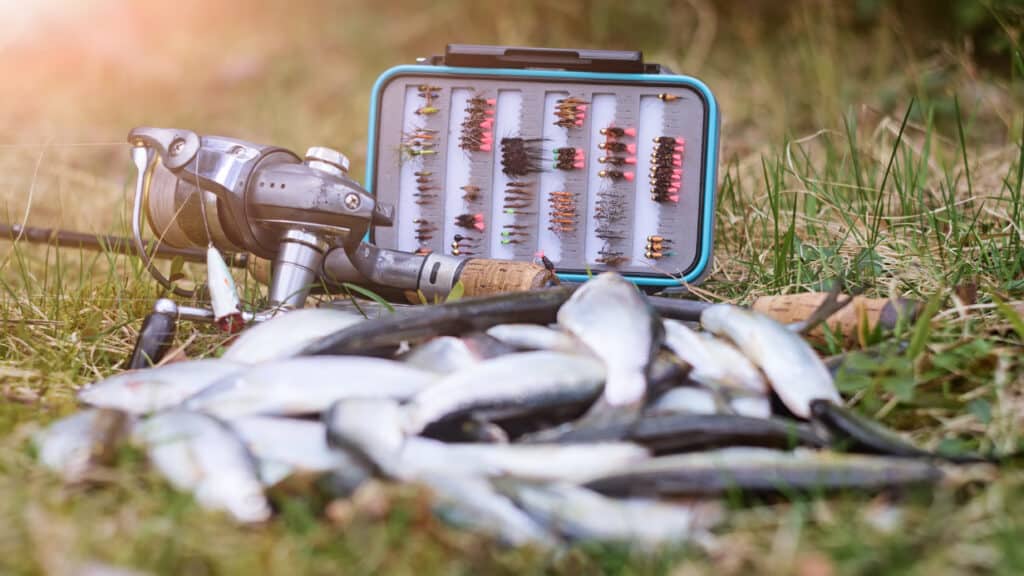
Step 1: Start by taking all your rod pieces out of the protective sleeve.
Step 2: Next thread the pieces of the rod into one another, the hold should be firm but not over-tightened.
Step 3: Now your rod is assembled, depending on what type of reel your fishing, slide the reel into the rod and fasten shut. The mechanism is fairly straightforward and usually found a foot or so from the base of your rod.
Step 4: Free your line from the reel and thread it through all the eyes of the rod, leaving at least a meter of line hanging from the tip of the rod.
Step 5: Your rod and Reel are now set up. The next thing you’ll want to do is tie a rig of your choice onto your main line.
Setting up your rod and reel is a generic factor of fishing. The basic principle of rod fishing is fairly straightforward to grasp and fairly generic whatever you’re fishing for.
Salmon Fishing Rigs
When starting off we found keeping the rig simple will work wonders. Having some light and strong line on your reel combined with any durable knot of your choice and attaching the fly/lure to the mainline with some fluorocarbon is ideal.
Theres plenty of complicated rigs for drift fishing involving multiple components however if you’re just starting the most basic of rigs will get you that all-important experience. Practice casting your rig out into the river and reeling in. Once you’ve mastered that technique then trying different rigs can also improve your fishing.
Heres an example:
Best Salmon Fishing Baits
Salmon are always on the move, this means their natural food consists of small fish, crustaceans, and plants. However conventionally salmon are caught with lures and flys that are designed to replicate their natural diet. The market is full of baits and additives that do in some cases improve bite frequency, however, its clear the most effective methods are the most popular. Sticking to a basic lure or fly typically is the way to go.
Lures: A bright lure that contrasts the water nicely will do the trick perfectly, something with a good hook ratio and a decent amount of weight is ideal. Lures are designed to replicate small fishing in the water, using your rod to mimic the moment of a small fish could make all the difference. The key thing to remember here is practice makes perfect.
Flys: These baits replicate bugs that land on the surface of the water. They are a common food for salmon and make excellent bait. The general technique behind using these as bait is to skip your fly across the surface of the water with the intention that a salmon goes for it. Using polarised sunglasses can aid with accuracy as well as locating the salmon. Known as fly fishing, this technique will take some practice to master.
Another popular bait that is used to catch salmon are fake eggs, bright rubber balls, and foam baits. These all require you to spend more time tying a rig and may take some practice to master. If you are interested in learning a fairly simple way to incorporate these baits into your fishing here’s a video that explains exactly how to tie that rig:
How To Locate Salmon
When it comes to locating salmon the first thing you’ll want to do is find popular rivers that are well-known for healthy salmon stocks. To make things easier here’s some information regarding the top rivers for catching salmon throughout the UK. Where to catch salmon in the UK.
Generally Salmon tend to enter our rivers in late winter. They will travel up or down rivers all the from January till August. Lucky for us that gives us plenty of time to catch them. Depending on where you are fishing, different rivers are known for producing the most salmon throughout the season. Acquiring this information before you start fishing is defiantly worthwhile.
Learning the river is always your best bet when it comes to locating the fish. You want to look for the swirls and bubbles in the water, combined with shallow snaggy areas. Such locations are usually where fish tend to be present however every river is different. It’s important to note that different styles, coulors, and sizes of lure will affect your fishing in a positive or negative manner depending on the river.
An excellent strategy we like to implement when fishing a new stretch of water is simply to speak to the regular anglers. You might get a mix of responses however you’ll hopefully walk away with some crucial information.
How To Improve Bite Frequency
When aiming to increase bite frequency, learning the fundamentals of the river your fishing is your best bet. Changing your location and traveling with the salmon has worked for us in the past. However, finding a hot spot will take some time and experience. Essentially the more you fish a river the more you’ll understand its complexities allowing you to determine when and where the fish are more likely to be throughout the year.
Swapping out lures and baiting up is a common method of increasing bite frequency. A small change can in some cases make all the difference. Using the correct gear for the task can also improve your bite frequency. The size of the river and the fish that you’re aiming to catch will have a significant impact on the gear you’ll use.
Using salmon eggs as bait can be an excellent way to get the salmon into a feeding frenzy. There’s no magic pill for catching salmon as they can be very wary at times however this technique has proven to be successful. Salmon are a strange fish from the way they physically change throughout the spawning season to their sometimes ferocious nature. Nevertheless, they are prized for their flavour all over the world. Catching them could mean a fantastic feast if you’re fishing a river where its permissible to catch and keep!
The easiest way to find this out is to give the venue a quick call before you set of as well as check with the locals.
When Is The Best Time To Go Salmon Fishing
Late summer and early Autumn is generally the best time of year to go salmon fishing. Although every river is slightly different in terms of when the salmon with spawn, using this as a guideline to plan your fishing trips is well worth it.
In all honesty, if you are just getting started, giving it a go whenever you can is always the best way to gain that essential experience that allows you to improve significantly as an angler.
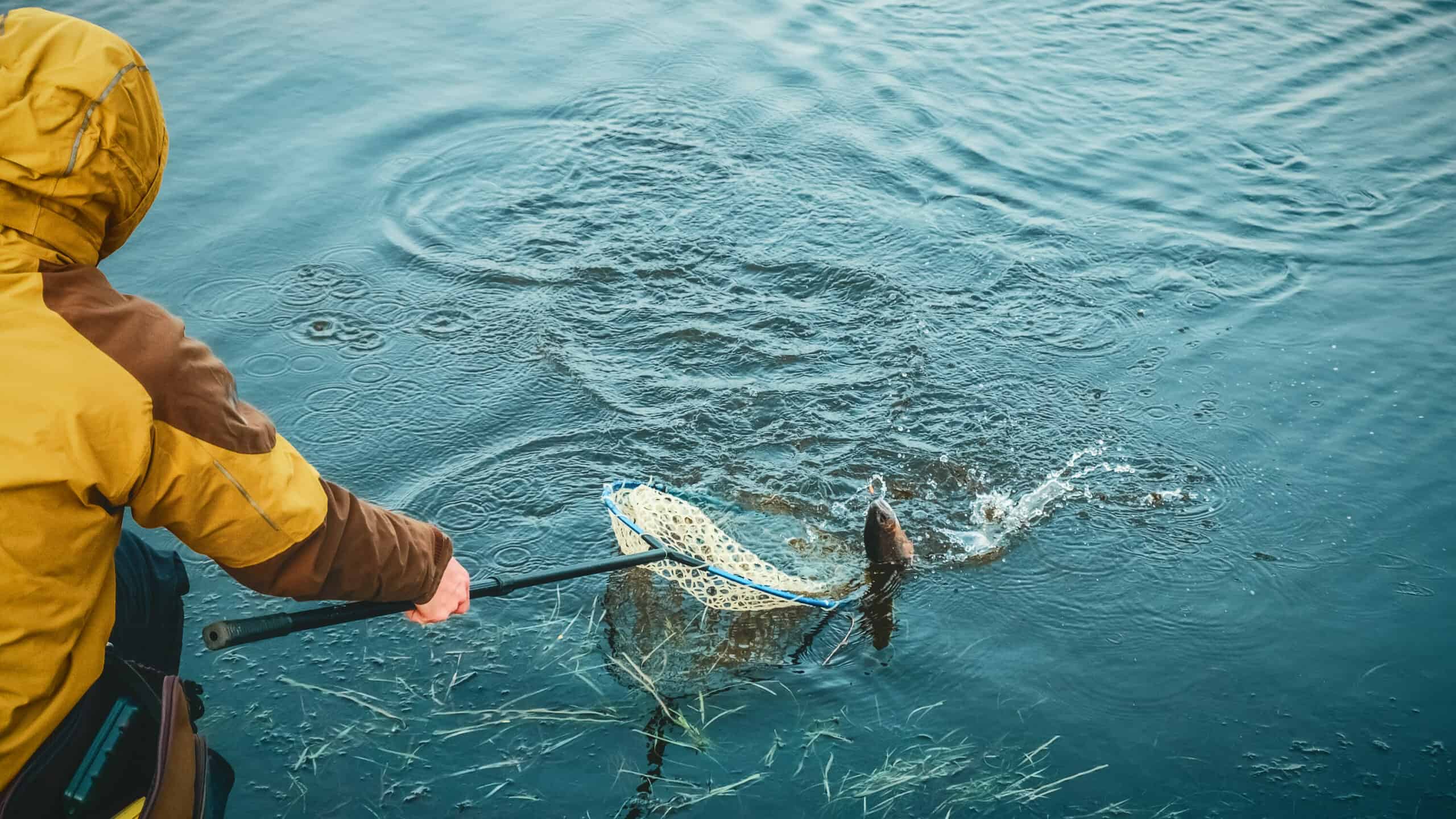
How To Handle Salmon
Once you’ve caught your Salmon there are a few things to always remember. If your fishing catch and release you want to reduce any contact you have with the fish. Unhooking your catch in the water is best but if this isn’t an option then keeping your salmon as wet as possible will ensure it has the best chances of recovery once released. Salmon fight extremely hard and do tend to be exhausted when they land in our nets. Giving them a few minutes in shallow water to let the water run through the gills is a common practice that helps those salmon get back to swimming in that harsh current.
Theres many different unhooking tools on the market that may appeal to some anglers, however, they aren’t entirely necessary. If your being quick with your unhook and release whilst being as gentle as possible your salmon will have no problem returning to normal.

